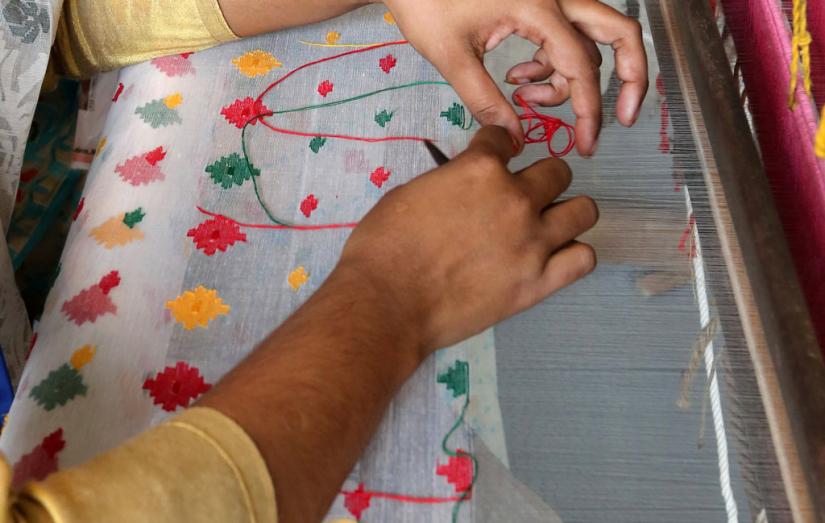 Jamdani is a fine muslin fabric originated in Bangladesh, not very new in the global map. The opulence of jamdani design not only makes it’s a technical marvel but also guarantees its omnipotence in the handloom industry, no machine could ever surpass its richness. The much appreciated and cherished art of Jamdani weaving of Bangladesh has been duly recognized by UNESCO as the intangible cultural heritage in 2013. It is at the same time recognition for weavers.
Jamdani is a fine muslin fabric originated in Bangladesh, not very new in the global map. The opulence of jamdani design not only makes it’s a technical marvel but also guarantees its omnipotence in the handloom industry, no machine could ever surpass its richness. The much appreciated and cherished art of Jamdani weaving of Bangladesh has been duly recognized by UNESCO as the intangible cultural heritage in 2013. It is at the same time recognition for weavers.
The genesis of it can be traced back to the Mughal era, but its place of origin was Sonargaon, Dhaka, Bangladesh. Sonargoan, Bangladesh still continues to be the hub of jamdani or as the local call it jamdani palli. The word Jamdani has been derived from the Persian word ‘Jam’ meaning flower and ‘Dani meaning vase. As the name suggests jamdani traditionally had flower motif vividly woven on a loom into the finer fabric by expert craftsmanship.
During the Mughal era, the jamdani and muslin production was at its zenith as it was patronized by the Mughals. The region around Dhaka was naturally blessed with the type of cotton called ‘Kapas’, which could produce fine, long and soft cotton fibres. The Julahas or weaver would then turn this fabric into unparalleled jamdani sarees. The region around Dhaka, between the Old Brahmaputra, Meghna and Shitalakhya rivers was very fertile and suitable for growing this cotton. The water in these rivers was rich in minerals and the soil in the river banks contained sufficient moisture and heat, all of which aided the cultivation. The river water was used to dye and clean the cotton, and its mineral content gave a glaze to the cotton fabric. The network of rivers not only aided in giving the julahas the finest fabric but also in transportation and providing the local and overseas market.
 Jamdani is known, not only for the finesse or intricate fabric but also for being overly priced. The hard work and toil of the weavers are not known by many. The cotton threads are dyed and is strengthened and softened by soaking overnight in a solution of rice water starch, allowing the women to wind it more easily onto bobbins. It is tedious work done early in the morning, usually between 4 and 9, before the increasing heat dries the thread, making it more difficult to handle. The wound bobbins are sent to another worker who prepares the warp on a beam. Afterwards, the warp is sent to the weaver’s house where it is set up on a loom. Interestingly the designs are woven directly into the fabric by a weft technique. Usually, two men work at one time on a loom.
Jamdani is known, not only for the finesse or intricate fabric but also for being overly priced. The hard work and toil of the weavers are not known by many. The cotton threads are dyed and is strengthened and softened by soaking overnight in a solution of rice water starch, allowing the women to wind it more easily onto bobbins. It is tedious work done early in the morning, usually between 4 and 9, before the increasing heat dries the thread, making it more difficult to handle. The wound bobbins are sent to another worker who prepares the warp on a beam. Afterwards, the warp is sent to the weaver’s house where it is set up on a loom. Interestingly the designs are woven directly into the fabric by a weft technique. Usually, two men work at one time on a loom.
During the British colonialism, the Bengal jamdani and muslin industries rapidly declined due to colonial import and rise in industrially manufactured products. It was difficult to compete with cheaper industrial product. The weavers toiled harder and suffered greatly as they were unable to match the cost and swift production of machines. Jamdani is a labour-intensive form of weaving, a final product may take five months or more. The final product of handloom jamdani was a product of unparalleled technical marvel and finer creativity of the artisan. In their endeavour to keep up the tradition of jamdani, the artisans have through ages hold on to their exquisite splendour of creativity and passed on to their posterity.
 It is a craft process that was at the verge of extinction, but with the unfaltering efforts of the finer weaver, the fine artistry of jamdani has not died out. The Jamdani Industrial Estate and Research Centre was established by the Bangladeshi government as an initiative to improve the jamdani industry. Bangladesh Small and Cottage Industries Corporation (BSCIC) was set up in 1982, to boost up the jamdani industry. National Crafts Council of Bangladesh (NCCB) since its inception in 1985 is engaged in the field of craft research and development. It not only promotes the craft sector but works towards maintaining the originality of craft traditions, benefits the poor weavers in ensuring their livelihood. They have collaborated with the biggest handloom/craft fashion houses of Bangladesh - Aarong, Aranya, Tangail Saree Kutir and Kumudini They organize Jamdani festivals and brings forward different aspect of the jamdani to the people. They tried to recreate the famous “the loom figured Muslin” and the antique designs of Jamdani.
It is a craft process that was at the verge of extinction, but with the unfaltering efforts of the finer weaver, the fine artistry of jamdani has not died out. The Jamdani Industrial Estate and Research Centre was established by the Bangladeshi government as an initiative to improve the jamdani industry. Bangladesh Small and Cottage Industries Corporation (BSCIC) was set up in 1982, to boost up the jamdani industry. National Crafts Council of Bangladesh (NCCB) since its inception in 1985 is engaged in the field of craft research and development. It not only promotes the craft sector but works towards maintaining the originality of craft traditions, benefits the poor weavers in ensuring their livelihood. They have collaborated with the biggest handloom/craft fashion houses of Bangladesh - Aarong, Aranya, Tangail Saree Kutir and Kumudini They organize Jamdani festivals and brings forward different aspect of the jamdani to the people. They tried to recreate the famous “the loom figured Muslin” and the antique designs of Jamdani.
The Craft organizations are also organizing an event on their own in promoting Jamdani. The Different Embassies of Bangladesh are also contributing in their own ways of promoting, Jamdani, the pride of Bangladesh. The Jamdani diplomacy of presenting high officials of different countries is a way to enhance the recognition and appreciation of jamdani in foreign soil. Our growing Bangladeshi diaspora and growing economy have opened up the horizon for jamdani and its popularity, which was otherwise restricted to West Bengal, Tripura and Assam. To make it available to a wider group jamdani is now being made in kurtas, shalwar kameez, Panjabi for men and scarves etc.
Today the Bangladeshi women take pride in wearing Jamdani in national events. Jamdani saree has become a symbol of identity, dignity and self-recognition for Bangladeshis. Others who join the fold of Jamdani feel it is one the most expensive and delicate fabrics and at the time a symbol of aristocracy. Jamdani makes us feel so Regal.
Shehnaz Rokeb, by profession a teacher, got masters in English Literature. She has a passion for promoting the culture, tradition and heritage of Bangladesh in other countries. She has done a few courses and training on teaching and literature. She is a voracious reader and likes to pen down her thoughts.


